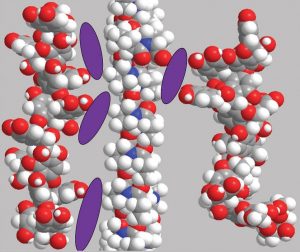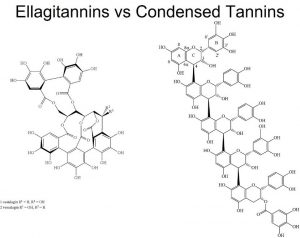
The only time I get a headache from wine is when I try to understand tannins. For years scientists have been attempting to analyze tannin evolution in wine, but even they’ve been stumped. Famous researcher quotes include Doug Adams from UC Davis who called the wine-tannin interaction “a chemical train wreck.” And Paul Smith of Australian Wine Research Institute (AWRI) called it a “freaking nightmare.”
Yet here I go, attempting to make some sense of it.
Let’s start at the beginning: what is a tannin? It’s a group of similarly structured polyphenolic compounds identified by their ability to bind with and precipitate proteins. Tannins are associated with astringency (caused by tannins binding with salivary proteins) and bitterness. In wine, there are hydrolysable tannins (from oak) and condensed tannins (from skins and seeds of grapes). Hydrolysable tannins (ellagitannins) in wine are typically at concentrations 5 to 10 times smaller than grape tannins.
Tannins in grapes (pre-fermentation) have been easy to test and understand. It’s what happens to the tannins during and after fermentation that’s difficult to track. According to James Kennedy, former Director of Viticulture and Enology Research Center at California State University, Fresno, “There is no question that our understanding of what tannins are is at a high point prior to veraison.” He says by the time a wine is three years old, we can chemically define less than 50% of the isolated material that we call tannins. This is because tannins in wine are always changing, polymerizing (binding with other molecules) and de-polymerizing.
Luckily a few brave scientists (Kennedy, for one) have dedicated their careers to understanding tannin chemistry, and they’ve been developing smarter technology for testing. So we are on the cusp of a deeper understanding. As a result, we’re learning that what we previously accepted as fact about tannins is, sort of…wrong (see “Everything You Know About Tannins Is Wrong). Here’s one: longer-chain tannins are less astringent than shorter-chain tannins. Not so! Newer research shows that larger tannins (such as those found in grape skins) are MORE astringent than smaller tannins. WTF?
Furthermore, tannins don’t necessarily develop into longer and longer chains, then precipitate out after aging, as previously thought. About ten years ago, the AWRI conducted a phenolic analysis of a 50-year vertical of Coonawarra Cabernet Sauvignon and reported that the 50-year old wines had tannin levels comparable to, and sometimes higher than, much more recent vintages. Huh?
No one disputes that older wines taste softer and less astringent than younger wines with a lot of tannins. So something is happening to the structure of tannins over time that’s not so straightforward. The latest research tells us that tannins don’t necessarily develop into longer chains; they become more complex.

Grape tannin (left), salivary protein (middle) and aged tannin (right. Purple ovals indicate regions of available surface interaction. Practical Winery & Vineyard, January 2015 article on “stickiness.”
In the January 2015 issue of Practical Winery & Vineyard, an article on tannin “stickiness” explains that a young tannin starts out as a rod-like structure with more available surface for interacting with salivary protein, and as the tannin matures, it develops more of a globular structure, resulting in less available surface for interaction. The tannin becomes less “sticky.”
So where do oak tannins fit into this picture (this is a barrel blog, after all)? As it turns out, the impact might be minimal. Kennedy says, “Although oak barrels do not contribute much tannin to red wine, the structure of oak-derived tannins is different than grape-based tannins and interacts differently with oxygen.” It seems that barrels are useful for something involving tannins, but it might not be their direct interaction with the grape tannins that makes a difference; it might be the oxygen coming through the barrels that facilitates change.
What does oxygen do to tannins? It affects the process of polymerization of tannins and anthocyanins, which improve stability and quality of astringency and color. According to a study published in the January 2015 issue of Practical Winery & Vineyard in which air was introduced to red wine fermentations, “Air reduced the concentration and size of tannins, increased stable color formation and reduced the astringency of wines.”
And from the Australia Journal of Grape and Wine Research November 2015 issue: “The reduction in astringency intensity of red wine with barrel ageing is more likely to involve changes to the structure of tannins because of gradual oxidation and ageing processes.” Furthermore, the oxidation of hydrolysable tannins produces peroxides, which facilitates polymerization of condensed tannins. So while oak tannins play a limited direct role in astringency, their presence can still influence it by promoting structural changes in wine tannins.
But then there is this…
According to a Chene & Cie article about oak grain and wine élevage, (Practical Winery & Vineyard, July 2014), the concentration of oak tannins increases linearly between one and eight months and then decreases after eight to nine months in barrel “as tannins soften.” The article states that the softening of tannins is a result of polymerization (grape tannins combining with oak tannins), oxidation and precipitation. It says polymerization is the most important because it “forms new tannin compounds that contribute to a softer, rounder, silkier mouthfeel,” and tannins lose some of their astringency. The polymerized compound that gets the most attention is Acutissimin A because of its anti-carcinogenic effects. In 2003 scientists established that red wines aged in oak barrels contain flavono-ellagitannins (formed by the binding of grape flavonoids and ellagitannins, particularly “vescalagin”), which were not present in oak or wine separately.
I don’t think the scientists have discounted the formation of these flavono-ellagitannins, but perhaps it’s not so clear how much they impact astringency versus other molecule combinations and evolutions.
Sigh….
What else do we know about oak tannins and wine? Thomas Collins, who is the former head of Research & Development for Treasury Wine Estates and partnered with UC Davis to conduct multi-year barrels trials, says that tannin content in oak (ellagitannins) “can vary based on the geographic origin of the tree, its species, individual trees in a forest, and the location on the tree from which the barrel stave is milled” (Vineyard & Winery Management 2013). He says that air seasoning can decrease the ellagitannin content, as can toasting. There could be a 72%-99% loss of ellagitannins during toasting. That’s significant! Lighter toasts generally resulted in less tannin loss. This reinforces the idea that oak tannins might have little impact on wine tannins. However, Chene & Cie says that after a certain period of time in the barrel, the wine reaches a layer of wood that has been less transformed by the toasting process. So if a wine is aged in barrel for long enough (I’m not sure how long), it could be more impacted by the oak tannins.
I don’t think my brain is designed to handle this level of chemistry and confusion, hence the headache, so let’s wrap this up. Here are some takeaways:
- Larger tannins are more astringent than smaller tannins (except possibly in older wines).
- Ellagitannins (oak) are smaller than condensed tannins (grapes skins and seeds).
- Tannins don’t necessarily evolve into longer chains but more complex ones.
- Aged wines tend to be have larger tannins and similar concentrations compared to young wines.
- Introducing oxygen to wine reduces astringency.
- Oak tannins bind with flavonoids to form more complex structures (Acutissimin A, for one).
- Oak tannins are diminished by seasoning and toasting.
Confused? Join the scientists.

Bravo! Very nice summary of oak aging.
Wow.. beautifully explained